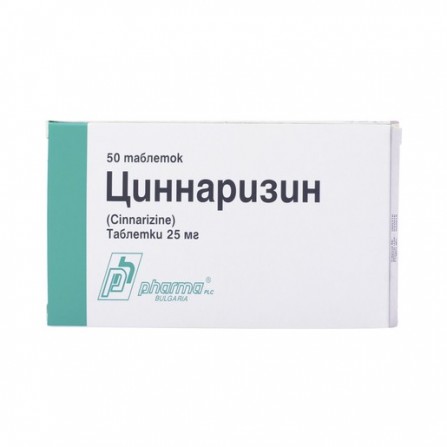Cinnarizin-sopharma pills 25mg N50
Condition: New product
1000 Items
Rating:
Be the first to write a review!

More info
Active ingredients
Cinnarizine
Release form
Pills
Composition
Composition 1 tab. cinnarizine 25 mg. Excipients: wheat starch, lactose monohydrate, polyvinylpyrrolidone K25, aerosil 200, magnesium stearate, microcrystalline cellulose. 50 pcs. - blisters (1) - packs cardboard.
Pharmacological effect
Cinnarizine improves cerebral and peripheral circulation by inhibiting the action of a number of endogenous vasoconstrictors and the flow of calcium ions into cells through the blockade of slow voltage-dependent calcium channels. It has a vasodilating effect especially in relation to the vessels of the brain, without having a significant effect on blood pressure. Increases the elasticity of erythrocyte membranes, their ability to deform, reduces blood viscosity, increases the resistance of muscles to hypoxia. It shows moderate antihistamine activity, reduces the excitability of the vestibular apparatus, lowers the tone of the sympathetic nervous system.
Pharmacokinetics
Absorbed relatively slowly in the digestive tract. Cmax in plasma is achieved 1-3 h after oral administration. Associated with plasma proteins by 80%, with erythrocytes by 13%. The distribution in the tissues is more intense within 4 hours after ingestion. Fully metabolized in the liver, mainly by N-dealkylation. T1 / 2 is 3-6 h, displayed in the form of metabolites: 1/3 - by the kidneys and 2/3 - with feces.
Indications
Adults and children over 12 years of age: prevention and treatment of peripheral circulatory disorders (obliterating endarteritis, thromboangiitis obliterans, Raynaud's disease, diabetic angiopathy, thrombophlebitis, trophic disorders (trophic and varicose ulcers), paresthesias, night spasms and cooling in the limbs). Prevention of kinetozov (road sickness of sea and air sickness). Symptomatic treatment of labyrinth and vestibular disorders of vascular origin, Meniere's disease.
Contraindications
Pregnancy. Lactation period. Children's age up to 12 years. Lactase deficiency, galactosemia or glucose-galactose malabsorption syndrome. Celiac disease (gluten enteropathy). Hypersensitivity to the drug. With care: Parkinson's disease.
Precautionary measures
Since the cardiovascular system: a decrease in blood pressure.From the nervous system: headache, fatigue; in patients taking high doses of cinnarizine, ectraliamidal symptoms (tremor of the limbs and increased muscle tone, hypokinesia, disorientation, imbalance), including Parkinson's syndrome, depression, may occur. On the part of the digestive system: dry mouth, pain in the epigastric region, dyspepsia; extremely rarely - cholestatic jaundice On the part of the skin: increased sweating; in extremely rare cases, lichen planus and lupus-like reactions.
Use during pregnancy and lactation
Due to the lack of well-controlled clinical studies regarding the safety of use in pregnant women, the use of cinnarizine during pregnancy is not recommended. Due to the lack of data regarding excretion into breast milk, the use of cinnarizine during breastfeeding is undesirable. In cases where the use of the drug is necessary, feeding with the food should be stopped.
Dosage and administration
Adults and children over 12 years old Inside, with plenty of fluids, after meals. In case of violation of the peripheral circulation - 50-75 mg (2-3 tab /) 3 times / day. With a high sensitivity to the drug, treatment begins with 1/2 the dose, increasing it gradually. To achieve the optimal therapeutic effect, the drug should be taken continuously, for a long time - from several weeks to several months. When vestibular disorders - 25 mg 3 times / day / With kinetosis - 25 mg 30 minutes before the upcoming road (if necessary, re-admission of 25 mg in 6-8 hours). When labyrinth disorders - 25 mg 3 times / day. The maximum daily dose should not exceed 225 mg.
Side effects
The most common - drowsiness, gastrointestinal discomfort, which in most cases are transient in nature and take place with a decrease in dose. Other less common: Side effects: Cardiovascular reduction of blood pressure. From the nervous system: headache, increased fatigue . In patients taking high doses of cinnarizine, ectraliamid symptoms (tremor of the extremities and increased muscle tone, hypokinesia, disorientation, imbalance), including Parkinson's syndrome, depression, may occur. Dry mouth, epigastric pain, dyspepsia. Extremely rare - cholestatic jaundice.On the part of the skin: increased sweating. in extremely rare cases - lichen planus and lupus-like reactions. Skin rash. Allergic reactions. Others: weight gain.
Overdose
Symptoms: vomiting, drowsiness, decreased blood pressure, tremor, coma. Treatment: in cases of overdose - gastric lavage, activated carbon. Symptomatic remedies are used. There is no specific antidote.
Interaction with other drugs
Enhances the effect of ethanol (alcohol) and sedative drugs. When used simultaneously with nootropic, antihypertensive and vasodilator enhances their effect. Reduces the effect of hypertensive drugs.
special instructions
Cinnarizine can cause gastric discomfort. Taking pills after eating reduces irritation of the gastric mucosa. Patients suffering from Parkinson's disease, cinnarizine should be prescribed only if its benefits exceed the possible risk of deterioration. Patients over 65 years old who have extrapyramidal disorders in their family history or clinical symptoms should be under constant medical supervision. In persons prone to lowering blood pressure (hypotension), it is necessary to monitor the values of blood pressure during treatment. Cinnarizine can cause a false-positive reaction when performing anti-doping tests on athletes. With prolonged use, it is recommended to conduct a control examination of the function of the liver, kidneys, and a picture of peripheral blood. Due to its antihistamine effects, cinnarizine can lead to false negative results for skin sensitivity tests. Treatment of cinnarithium should be canceled 4 days prior to studies. Impact on the ability to drive vehicles and control mechanisms During the period of treatment, care must be taken when driving vehicles and occupations of potentially hazardous activities that require high concentration of attention and speed of psychomotor reactions.




